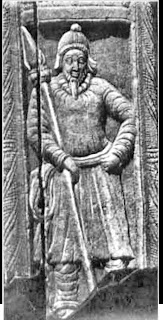The Ikshvakus ruled parts of present-day Andhra Pradesh and Telangana during the 3rd and 4th centuries AD, from their capital at Vijayapuri (modern Nagarjunakonda in Andhra Pradesh). Even though, they ruled for some time, their contribution to the culture is immense.
Ikshvaku coin
Ancient Sanskrit texts, such as the Rigveda, Atharvaveda and Jaiminiya Upnishad Brahmana, mention a legendary king named Ikshvaku (literally, "gourd"). Later texts, such as the Ramayana and the Puranas, connect the dynasty of Ikshvaku's descendants to Ayodhya, the capital of the Kosala Kingdom in northern India.
The dynasty's founder Vasishthiputra Chamtamula rose to power after the decline of the Satavahana power. He is attested by the Rentala and Kesanapalli inscriptions. The four-line Kesanapalli inscription dated to his 13th regnal year, and inscribed on the pillar of a Buddhist stupa, names him as the founder of the Ikshvaku dynasty.
Nagarjunakonda Ayaka pillar inscription of the time of Vira-Purushadatta, 250-275 AD
Chamtamula's son Virapurushadatta ruled for 24 years and is attested by an inscription dated to his 24th regnal year. He married Rudradharabhattarika, daughter of the ruler of Ujjain, possibly the Indo-Scythian Western Kshatrapa king Rudrasena.
He was succeeded by his son Ehuvala Chamtamula, who also ruled for more than 24 years and is attested by inscriptions dated to many of his regnal years. His Patagandigudem inscription is the oldest known copper-plated charter from the Indian subcontinent.
His was succeeded by his son Rudrapurushadatta, whos Nagarjunakonda inscriptions record the erection of a pillar to commemorate his rule.
Four Ikshvaku rulers are known from the inscriptions and coins discovered, these were Chamtamula (210-250 CE), Virapurushadatta (250- 275 CE), Ehuvala Chamtamula (275-297 CE), and Rudrapurushadatta (300-325 CE).
An inscription dated to the 30th regnal year of the Abhira king Vashishthi- putra Vasusena has been discovered at the ruined Astabhuja-svamin temple in Nagarjunakonda. This has led to speculation that the Abhiras, who ruled the region around Nashik, invaded and occupied the Ikshvaku kingdom. However, it cannot be stated with certainty. By mid 4th century, the Pallavas had gained control of the former Ikshvaku territory and the Ikshvaku rulers may have been reduced to vassal status.
Ikshvaku dynasty, 227-306 AD, lead, weight 2.7 g
Obverse: Elephant to right
Reverse: Ujjain type symbol















No comments:
Post a Comment
Any inputs or feedback is welcome!